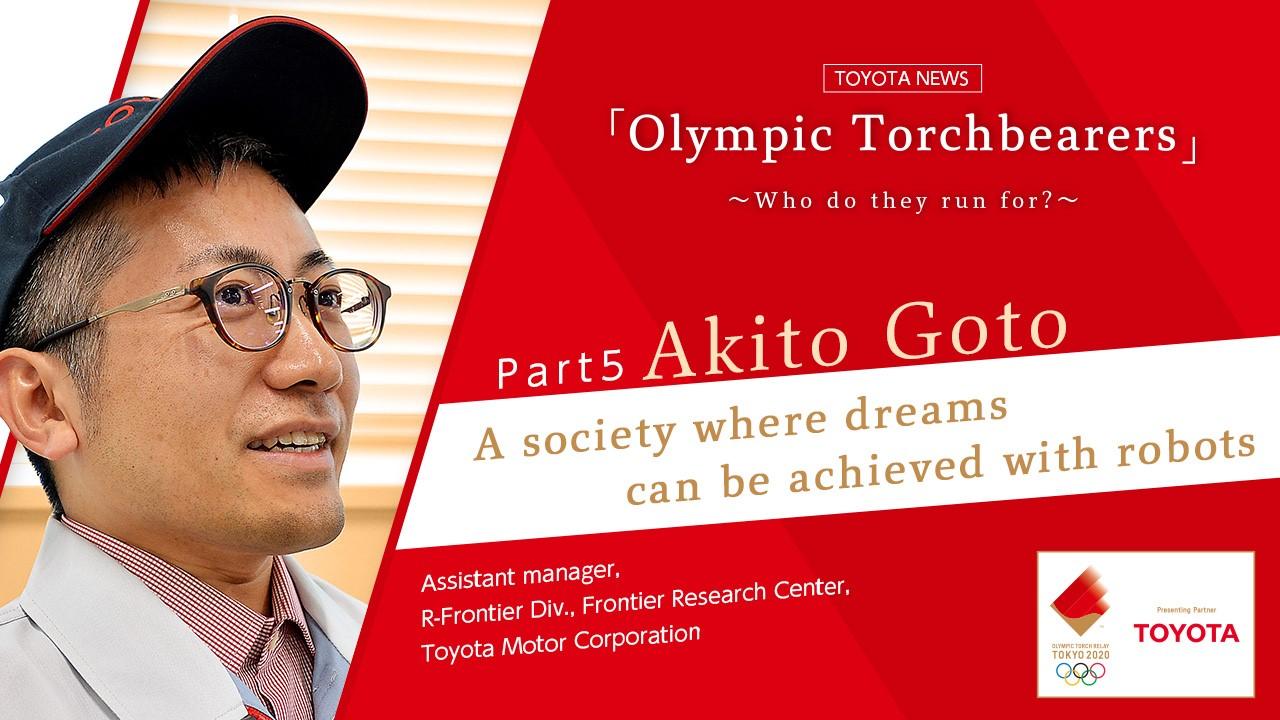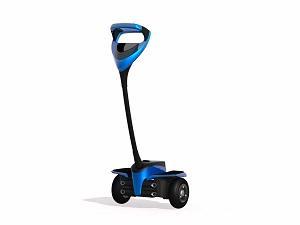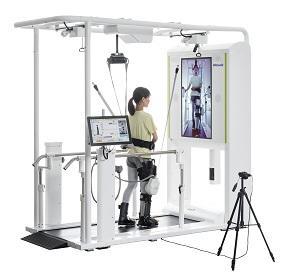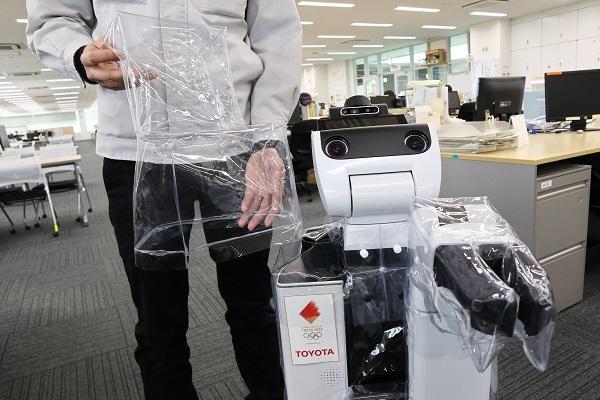
Running together with my partner robot will hopefully show how anyone can realize the 'freedom to move.'

Introduction
To Toyota Times readers,
Originally, this series of articles was scheduled to kick-off coinciding with the start of the Tokyo 2020 Olympic Torch Relay, on March 26, 2020. The series is designed to introduce the Toyota employees selected to serve as torchbearers.
These torchbearers have expressed a desire to share that they are not running for themselves, but that they are running "for someone else."
Unfortunately, with the postponement of Tokyo 2020, the Tokyo 2020 Olympic Torch Relay has also been postponed.
For the Toyota torchbearers, however, while not able to run right now, there is no reason to delay highlighting their reasons for running. Therefore, this series will continue as scheduled, and it is hoped that readers will come to understand the desires and expectations the torchbearers have placed on their involvement in this once-in-a-lifetime opportunity to run.
Akito Goto, Assistant Manager, R-Frontier Division, Frontier Research Center
Akito Goto smiles as he holds the Olympic torch together with a Human Support Robot (HSR), a robot that is adept at recognizing, taking hold of, and transporting objects. After joining Toyota in 2007, Goto started his career in the Partner Robot Division (the name of the division at that time), the division that was charged with robot development. He was assigned and involved in technology development for several projects: a personal mobility robot, dubbed ‘Winglet,’ and Toyota’s rehabilitation assist robot, ‘Welwalk.’ For about three years starting from 2016, he studied automotive production technology in the Electronic Components Production Engineering Division before returning once more to work on robot development in January 2019, which he continues to do to this day.


“My return (to robot development) was right at the time a new development project was starting up. Discussions were underway to see if there was anything that could be done to support divisions within Toyota experiencing labor shortages. So that was the starting point for a project launched to apply robotics technology to logistics to help create a better environment in automobile parts warehouses. I am currently involved with R&D for this project.
On the one hand, the Olympic and Paralympic Games Tokyo 2020 were fast approaching, scheduled to be held the following year. One of my desires was to be involved with Tokyo 2020 in some way, so I spoke with the product manager in the division charged with the development of robots that were destined for Tokyo 2020. His suggestion was to use robots in a way that could support the operations in some capacity. Ultimately, it was decided that our robots could provide services to spectators in wheelchairs at the Olympic Stadium, the main venue for both the Olympic and Paralympic Games.”
The development of life-assist robot technology for support services for Tokyo 2020 means that part of the focus will be on people with disabilities or impairments like Goto. He commented:
“There is a special subsidiary of Toyota where people with disabilities or impairments work called Toyota Loops. I am currently working with people from there to develop the services. Broadly speaking, there are two types of people we hope to have experience our services. The first are people visiting the venue as a spectator; the other types are people with disabilities or impairments who are looking for new ways to work.
For the latter group in particular, we are aiming to develop a new ‘remote working paradigm’ where people at Toyota Loops in Toyota City can connect using the internet to the venue and services offered at the Olympic Stadium in Tokyo. Through that connection, the idea is that they will be able to communicate with guests in wheelchairs, and then provide them with direct support by remotely operating the robots, Toyota’s Human Support Robots, that will be operating on-site at the stadium. If this can be achieved, we believe it will open up a whole new world for people like myself and those at Toyota Loops who have disabilities or impairments, ‘allowing us to carry out physical work through the remote operation of robots.’”“Entrusted hopes and desires” and a “message I want to deliver”
Goto, who will be directly supporting Tokyo 2020 from a remote location in Toyota City, was also selected to be an Olympic torchbearer.
“Someone could be recommended as an applicant or apply themselves. I wanted to run, so I raised my hand and applied. They said that candidates were being chosen based at least in part on the strength of their motivation, and I was lucky to be selected knowing that it meant I was being entrusted with ‘the hopes and desires’ of the people around me.”
Goto composed his application with the following words, highlighting his motivation:
“Since I was a child, moving anywhere has been a challenge due to a congenital disorder. After joining Toyota in 2007, it was the support from various people, including my family and colleagues, that brought me to where I am today. Many times I wanted to give up; however, I have always dreamt of creating a society where anyone could realize their dreams. I want people to know about and understand these values. If there is a physical impediment standing in the way of a challenge, it seems important that the many people struggling to overcome it know that there is a robot that can help solve those challenges. My motivation is to use the opportunity of the Olympic and Paralympic Games, which will attract the attention of many people, to deliver this message.”
Despite Goto’s forward-looking message, until around 2018 he did not focus as much on others as he did himself. Looking back, he says that when did stop to think about others, asking himself, “who can I do this (something) for…,” that answers were not readily forthcoming to mind.
“Then, my daughter was born in December 2018. This was motivating to me. The thought kept growing in my mind as I strongly wondered about what I might be able to do for her and her future children. This is the trigger that helped me consider ‘what I could do for society’ and ‘for people other than myself.’ Then I thought if I can work and inspire others, then what better way than to apply to be a torchbearer?”
For his portion of the Olympic Torch Relay, Goto was assigned to run about 200 meters while holding the Olympic torch. Although this may sound easy, for him it’s a challenge too big to come to terms with.
“I have an impairment that causes the joints in my limbs to be fragile. It is tough to walk or run long distances, and doing so places a heavy burden on my body. It is not that I don’t want to do it, it is more like I cannot do it. Very literally, for me, trying to run as a ‘torchbearer’ would be a very difficult mission.
Fortunately, the essence of being a torchbearer is not about speed. That said, I do not merely want to complete the 200-meter leg by only walking it – there is no grandeur in that. For me, it is still an enormous challenge.”
Giving meaning to “moving 200 meters”
Knowing the challenges, Goto was then asked a question about why he decided to attempt to become a torchbearer. His response was:
“The desire to be ‘free to move’ was really compelling. Riding a bicycle as a young child and again when driving a car as a student in my university days, allowed me to broaden my range of movement. In fact, because of experiences like those, I chose to join Toyota. I thought it would be good to contribute to helping all people have greater opportunity to move freely. On that note, my current involvement with robot development may not be directly linked to movement in the truest sense; however, it has made me more aware that there are various forms of mobility.
‘Moving’ 200 meters as a torchbearer is one form of mobility. I think for people in similar situations to mine, that if they could move a little bit easier to places, including what some might say is ‘just over there,’ and if there was an accumulation of things that made life just a little bit easier, people in general might take on more challenges.
The challenge is that those with disabilities or impairments inherently want to do things themselves as much as possible. However, it is difficult for them to do some of those things by themselves. Despite the challenges, they still insist on being able to do it for themselves rather than have someone do it for them. This is probably the honest feeling most people with disabilities or impairments have. My wish is that all people can have confidence that they can do things themselves, with the help of tools such as robots. The more positive experiences they have with these tools, the more likely they will become, motivated to then take on another challenge or an even more significant challenge than they would have otherwise. Hopefully, this can all be communicated via my participation in the relay.”
It is not just words either – Goto is doing his best to promote this message as he practices running with his Human Support Robot partner for the relay, along with his colleagues.

“Running on my own is already challenging enough; however, I believe there is meaning in running together with a robot as a partner. My role is to carry the torch while the robot is there to provide support. As technology advances, so will our experiences, allowing us to do things that have never been done before. By seeing me with a robot, I want people in situations like mine to get excited and realize that they can also obtain 'freedom of movement,’ which I hope will inspire them to take on new challenges.”
Goto hopes to help create a society where dreams can be achieved with robots. Catching a glimpse of Goto and a Human Support Robot working together, the robot as his colleague as well as partner holding the Olympic Torch together, one can’t help but imagine what a day in the future might be like – a future that may come soon.

